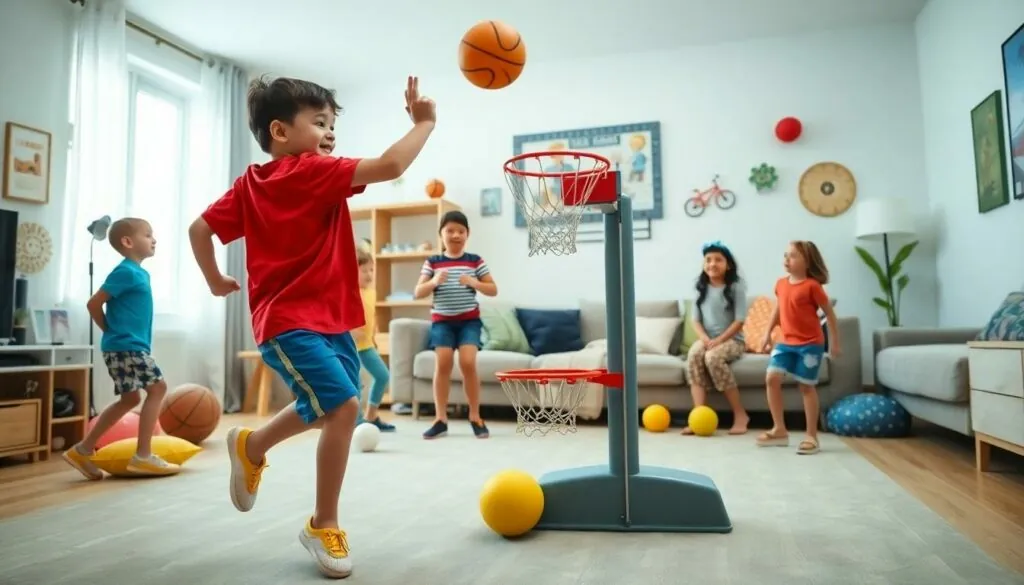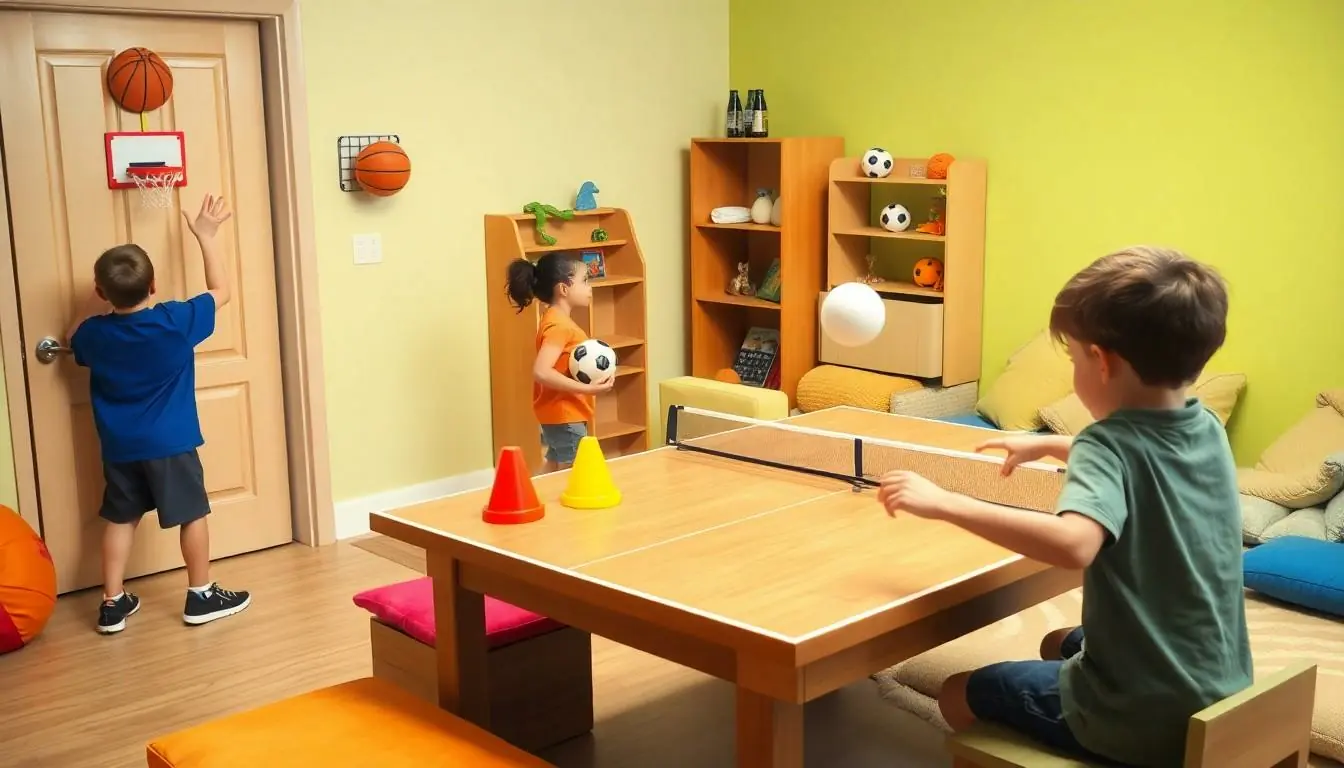Table of Contents
ToggleKeeping kids entertained indoors can feel like trying to contain a hurricane in a bottle. When the weather won’t cooperate or screen time has maxed out indoor sports games become the perfect solution to channel that endless energy into something fun and productive.
From mini basketball tournaments to indoor obstacle courses these activities don’t just keep kids moving – they help develop crucial motor skills coordination and social abilities. Plus they’re a fantastic way to avoid the dreaded “I’m bored” syndrome that every parent knows all too well. The best part? These games require minimal setup and can transform any living room into an exciting sports arena without breaking any valuable decorations (hopefully).
Benefits of Indoor Sports for Child Development
Indoor sports activities create a structured environment for children to develop essential life skills through play-based learning. These activities offer multiple developmental advantages in both physical and psychological domains.
Physical and Mental Growth
Indoor sports boost children’s motor development through activities like jumping, throwing, catching and balancing. Kids enhance their hand-eye coordination by practicing ball games, target shooting or juggling activities. The continuous movement in confined spaces improves spatial awareness while strengthening core muscles and overall fitness. Regular participation in indoor sports increases mental alertness, concentration and problem-solving abilities. Games that require strategic thinking promote cognitive development, memory retention and decision-making skills.
Social Skills Enhancement
Indoor sports create opportunities for children to interact, collaborate and communicate effectively with peers. Team-based activities teach kids valuable lessons in sharing, taking turns and respecting others’ abilities. Children learn leadership qualities by captaining teams, organizing game strategies and motivating teammates. Group games foster emotional intelligence as kids navigate winning, losing and conflict resolution. Structured indoor activities help children develop self-confidence, discipline and effective communication patterns through regular interaction with peers and instructors.
Classic Indoor Sports Games
Classic indoor sports adapt popular outdoor games for indoor spaces, providing engaging physical activities that maximize limited room while protecting furniture and decor. These timeless games offer structured play opportunities in compact areas.
Basketball Mini-Hoops
Mini basketball hoops transform any room into an indoor court with over-the-door mounting systems or freestanding units. Foam balls prevent damage to walls while maintaining authentic game mechanics. Kids practice shooting techniques from 3-6 feet away, developing hand-eye coordination through activities like HORSE, 21 points, or rapid-fire shooting contests. Multiple height adjustments accommodate different age groups, creating fair competition opportunities for siblings ages 4-12.
Indoor Soccer Activities
Soft foam soccer balls enable controlled indoor passing drills between players 5-8 feet apart. Kids enhance footwork through dribbling exercises around paper plate markers or sock cones. Target practice using laundry baskets or cardboard boxes as goals builds accuracy from 6-10 feet away. Two-player games focus on precision passing rather than power shots, maintaining safety in confined spaces.
Table Tennis Fun
Portable table tennis sets attach to dining tables or fold out as standalone units, requiring 12×6 feet of clear space. Players ages 6+ improve reaction time through singles matches or round-robin tournaments. Mini paddles designed for smaller hands help beginners master basic strokes. Progressive skill games like target hitting sequential numbered spots on the table surface enhance focus through structured challenges.
Creative Movement Games
Creative movement games transform indoor spaces into dynamic play zones where children explore physical expression through structured activities. These games combine athletic skills with artistic elements to create engaging experiences for kids of all ages.
Dance and Rhythm Sports
Dance-based activities enhance coordination through structured movement patterns set to music. Kids learn basic dance steps, follow rhythmic sequences, and participate in musical games like freeze dance or dance-off competitions. Popular options include:
- Ribbon dancing with colorful streamers to practice fluid movements
- Just Dance video games that combine technology with active choreography
- Musical yoga poses that build strength and flexibility
- Rhythm-based jump rope routines with counting sequences
- Action song activities incorporating specific movement patterns
Obstacle Course Challenges
Indoor obstacle courses develop agility through customized movement sequences using household items. Children navigate through:
- Cushion stepping stones placed strategically across the floor
- Tunnel crawls created from blanket-draped chairs
- Balance beams using painter’s tape lines on carpet
- Hula hoop stations for jumping or crawling activities
- Zigzag patterns marked with sock markers
- Limbo bars made from pool noodles between furniture
These configurations change regularly to maintain excitement and target different movement skills. Each course features 5-7 stations with specific tasks like hopping spinning or crawling.
Safe Indoor Sports Equipment
Indoor sports equipment designed for children emphasizes safety features while maintaining engaging play value. The right gear protects both kids and home interiors during active play sessions.
Age-Appropriate Gear
Sports equipment for toddlers (ages 2-4) includes soft foam balls, lightweight plastic bowling pins and oversized catching mitts. Elementary-age children (ages 5-8) benefit from adjustable basketball hoops, foam soccer balls and velcro target games. Older kids (ages 9-12) engage with table tennis sets, indoor golf putting mats and mini volleyball nets with foam balls.
Equipment specifications for different age groups:
| Age Group | Ball Size | Net Height | Safety Features |
|---|---|---|---|
| 2-4 years | 4-5 inches | 2-3 feet | Extra padding, rounded edges |
| 5-8 years | 6-7 inches | 4-5 feet | Impact resistant, non-slip bases |
| 9-12 years | 8-9 inches | 5-6 feet | Stabilizing weights, protective guards |
Space-Saving Solutions
Collapsible equipment maximizes play areas in compact spaces. Pop-up goals fold flat for storage under beds or in closets. Modular components stack efficiently between play sessions. Multi-purpose items serve different sports functions: adjustable nets work for badminton volleyball or tennis.
- Wall-mounted equipment racks with dedicated hooks for balls nets hoops
- Rolling storage bins with compartments for sorting gear by sport type
- Over-door organizers holding lightweight equipment in mesh pockets
- Vacuum-sealed storage bags compressing soft equipment when not in use
- Dual-purpose furniture incorporating equipment storage spaces
Organizing Indoor Sports Activities
Indoor sports activities create structured environments that promote physical development while keeping children engaged. Success lies in strategic planning of space usage combined with consistent scheduling.
Setting Up Play Areas
Dedicated play zones transform living spaces into safe sports areas through strategic furniture arrangement. A 10×10 foot clear space accommodates most indoor activities like mini basketball or dance games. Safety mats placed under activity areas protect floors while providing cushioning for jumps or falls. Zone markers made from colorful tape define boundaries for different games without damaging surfaces. Corner spaces work well for stationary equipment such as basketball hoops or target practice stations. Storage solutions including wall-mounted hooks or rolling bins keep equipment organized yet accessible. Clear pathways between zones prevent accidents during active play sessions.
Creating Weekly Routines
Structured schedules maximize participation in indoor sports activities throughout the week. Monday focuses on ball skills with basketball shooting drills. Tuesday incorporates dance-based movement games for cardio exercise. Wednesday features obstacle course challenges using portable equipment. Thursday includes target practice activities for precision development. Friday combines favorite activities from the week into mini tournaments. Morning sessions last 30 minutes for optimal engagement. Afternoon sessions extend to 45 minutes when energy levels peak. Each activity rotates through different skill levels to maintain interest. Achievement charts track progress across various games. Regular equipment checks ensure safety standards remain consistent.
Conclusion
Indoor sports games offer an invaluable solution for parents seeking to keep their children active engaged and growing. These activities transform ordinary living spaces into dynamic play zones that foster physical mental and social development.
With the right equipment planning and safety measures indoor sports create structured environments where kids can thrive while having fun. Parents can easily implement these games knowing they’re supporting their children’s development in multiple ways.
The beauty of indoor sports lies in their adaptability and accessibility. Whether it’s a rainy day or limited outdoor space these activities ensure children stay active while building essential life skills that will serve them well into the future.





